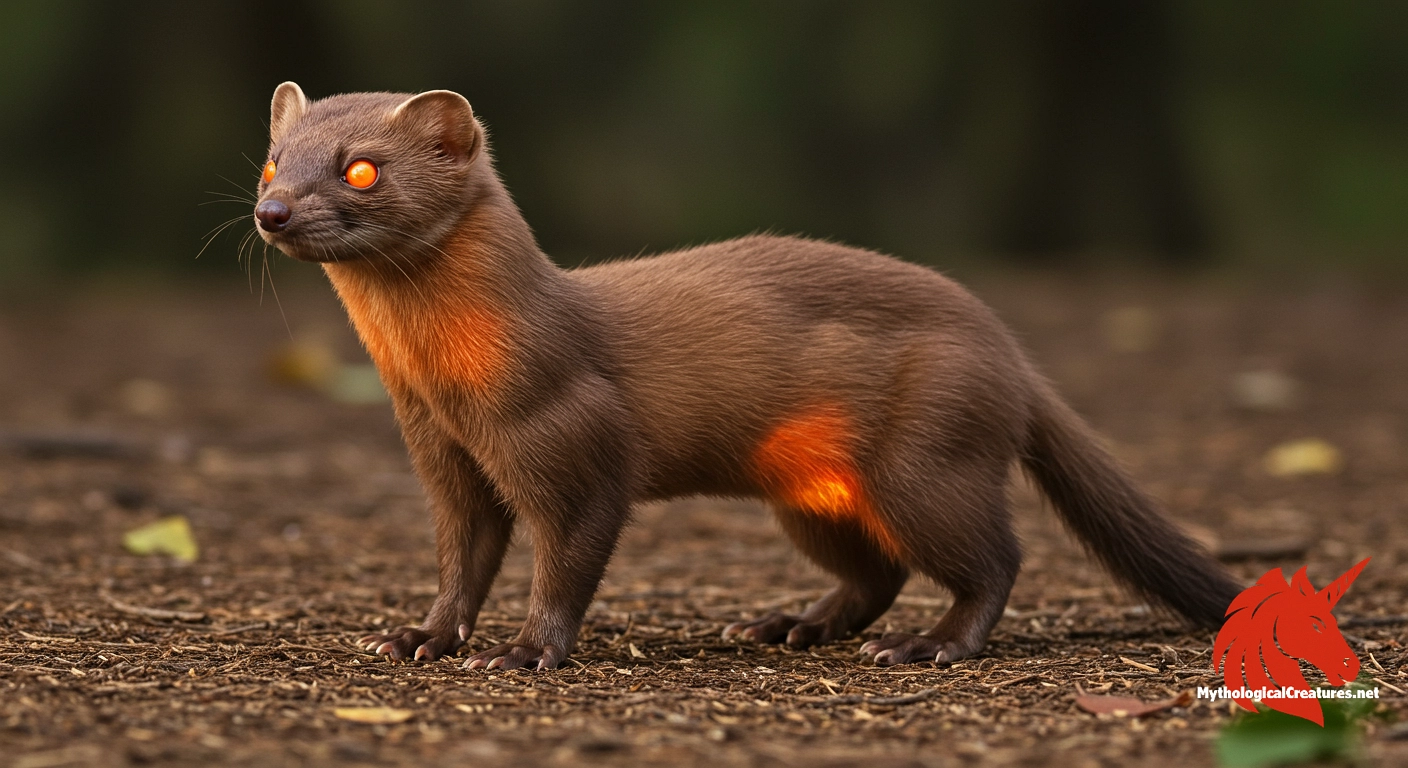Muscaliet: The Muscaliet is a mythical beast from medieval bestiaries noted for its composite animal traits and unusually high body heat.

Muscaliet
Muscaliet - Symbolises the unpredictable and destructive forces of nature, serving as a cautionary example in medieval literature.
Origins & First Encounters
The muscaliet emerges from the shadowed pages of medieval bestiaries as a creature both baffling and captivating. Its earliest known mention appears in the 13th century work of Pierre de Beauvais, where it is detailed as an animal of unusual composite traits. The creature’s origins seem to lie at the intersection of natural observation and imaginative allegory, blending the familiar with the fantastical. Its description, which borrows characteristics from hares, squirrels, weasels, moles and pigs, points to a deliberate attempt to exemplify nature’s mysterious diversity. The muscaliet is not merely an oddity but also a symbol of nature’s unpredictable forces, encapsulating both vitality and potential peril. Early medieval scholars saw in its contradictory features a representation of both the beauty and the hazard inherent in the natural world. The animal’s habit of nesting beneath the trees it climbs, coupled with its supposed ability to disrupt the life of the forest through intense body heat, further underscores its enigmatic status. As such, the muscaliet occupies a unique place in the tapestry of medieval lore, inviting continuous fascination through its perplexing and contradictory nature.
Source Texts & Tale Variants
The primary account of the muscaliet is found in Pierre de Beauvais’s 13th century Bestiaire, where it is recorded with a distinctive blend of animal traits. Subsequent medieval manuscripts occasionally allude to similar enigmatic creatures, each variant adding layers of complexity to its narrative. Some texts offer subtle differences in description, emphasising certain features such as its affinity with hares or its resemblance to moles, thereby reflecting the transmissible nature of oral tradition. In various recensions, the creature’s ability to damage trees through its innate body heat is stressed as a sign of its otherworldly power. Folkloric accounts sometimes morph the muscaliet into a broader symbol of natural mischief, with regional scribes adapting the narrative to local environmental concerns. Comparisons drawn with other bestiary creatures reveal an evolving interpretation that blends symbolic allegory with observed natural phenomena. Although its appearances in the literature are few and far between, the recurring inclusion of the muscaliet in these texts underscores its role as a cautionary emblem of nature’s inexplicable behaviours. Its layered portrayal in medieval sources continues to fascinate scholars, ensuring that the narrative of the muscaliet remains woven into the fabric of mythic tradition.
Form & Powers
The muscaliet is depicted as a chimera of sorts, its physical form merging the sinuous agility of a hare with the compact robustness of a pig. Its body is described as lithe yet sturdy, equipped with limbs that afford it remarkable dexterity in climbing trees. The creature’s fur, varying in hue and texture, evokes the soft appearance of squirrels and the furtive quality of weasels. Distinctive facial features, melding sharp, alert eyes with a slightly elongated snout, lend it an expression of both curiosity and cunning. Intriguingly, accounts emphasise a potent body heat that not only warms its immediate surroundings but is said to cause harm to the very trees it inhabits. This thermal attribute adds a surreal layer to its anatomy, suggesting an internal energy that defies natural expectations. Some descriptions hint at small protuberances along its back, possibly symbolising the coexistence of animal ferocity and the divine spark of chaos. The resulting image is one of a creature that is both a product of natural variation and a symbol of the medieval fascination with the unexplained.
Regional Faces
While the muscaliet originates from the milieu of French medieval bestiaries, its narrative has been subject to regional reinterpretation over time. In its native context, it is portrayed as a peculiar blend of common fauna, yet echoes of its lore have been found in less formal northern European accounts. In Scandinavian retellings, for instance, the creature’s association with both warmth and the disruption of nature is sometimes amplified by local legends that stress the capriciousness of natural forces in icy landscapes. In the Mediterranean region, adaptations of its myth have occasionally portrayed it as a minor forest guardian, whose destructive qualities serve as a moral lesson in environmental stewardship. Italian and Iberian storytellers have reimagined its physical characteristics, occasionally adding traits that align with regional fauna and local superstitions. These adaptations reflect a broader trend in medieval Europe, where localised folklore merged with canonical bestiary descriptions to enrich the creature’s mythos. The variances in portrayal often underscore regional concerns, whether of ecological imbalance or the interplay between nature and the supernatural. Thus, the muscaliet’s regional adaptations serve not only to underscore its mysterious inherent qualities but also to align its symbolism with evolving local cultural narratives.
Cultural Parallels
When considered alongside other mythological beings, the muscaliet stands as a distinctive example of medieval hybridity. Its composite traits invite comparison with similar creatures across various cultures, such as the curious amalgamations found in Eastern European legends and even North American cryptids. In many respects, the muscaliet shares a kinship with the more widely known chimeric beasts whose features combine several animals into a single form. Such comparisons highlight a common medieval desire to rationalise the irrational, grounding extraordinary natural phenomena in familiar imagery. Similar to the legendary jackalope, whose fantastical nature is bolstered by attributes borrowed from various species, the muscaliet functions as an embodiment of nature’s paradoxical character. Unlike other composites that lean heavily into the realm of the monstrous, however, it retains certain endearing qualities drawn from the gentler aspects of its constituent animals. The diverse descriptions found in bestiaries suggest that cultural transmission played a significant role in shaping its lore, as adaptations in one region would influence the narrative in another. In this way, the creature becomes a bridge linking disparate mythological traditions, each seeking to capture the essence of nature’s enchanting unpredictability.
Legacy & Modern Evolution
The legacy of the muscaliet is woven through the evolution of myth into modern storytelling, even as its original form remains enigmatic. In the centuries following its initial documentation, the creature gradually slipped from the mainstream of myth, yet its essence endured in the allegorical tapestry of literature and art. As rational thought began to overshadow the fantastical, the muscaliet was often reinterpreted in metaphorical terms to symbolise nature’s ambivalence towards human intervention. Contemporary fantasy literature and visual media now occasionally resurrect such medieval oddities, casting them in roles that speak to modern themes of environmental disruption and the blurred boundaries between science and myth. Its peculiar traits have inspired artists to explore themes of hybridisation and the unpredictable power of nature. In some modern adaptations, the muscaliet’s ability to damage trees is reimagined as a metaphor for the consequences of ecological imbalance, reflecting current environmental concerns. Even as it recedes into the background of classical myth, the creature’s enduring mystique serves as a reminder of the human fascination with the unexplained. Through reinterpretations in digital media, graphic novels, and speculative fiction, the muscaliet continues to symbolise the timeless allure of beings that defy ordinary categorisation and challenge our perceptions of the natural world.
Interesting Fact
The Muscaliet's rare ability to damage trees solely with its body heat offers a striking example of how medieval bestiaries blended natural observation with mythological symbolism.
Quick Creature Info
Features:
Associations:
Our Mythic Legendary Rating:

Habitat:
Supernatural Powers:
Physical Attributes:
Abilities:
Behavior:
Weaknesses:
Lore:
Related Creatures, Tales or Lore
References
Discover Another Mythical Legend You May Not Have Heard Of?
Uncover the mysteries of ancient folklore and expand your knowledge of legendary beings from cultures around the world.
Dare to Meet the Sabazios....
Mythical Disclaimer: The images and data on this site are derived from various historical and literary sources, but we have found that many myths often have multiple versions and interpretations across references, sometimes contradictory. As a result, these creature depictions are artistic interpretations—imaginative blends of folklore, legend, and a dash of AI guesswork. Because creature descriptions vary widely, our illustrations and accompanying information represent our best effort to honor mythology while bridging creative gaps. Enjoy these interpretations—just remember, we've done our best to respect the stories and validate available data, but in the realm of mythology, details often shift, imagination leads the way, and nothing is ever set in stone!
Curated by the Mythological Creatures Team (rev. May 2025)
